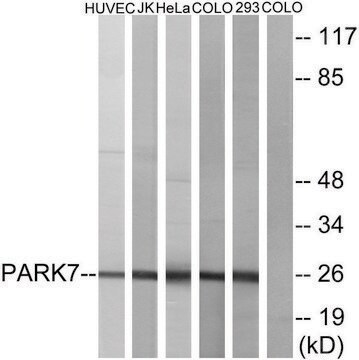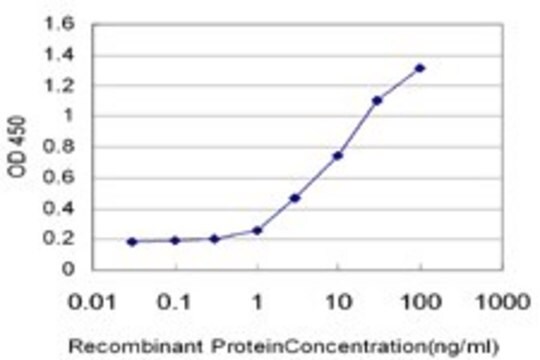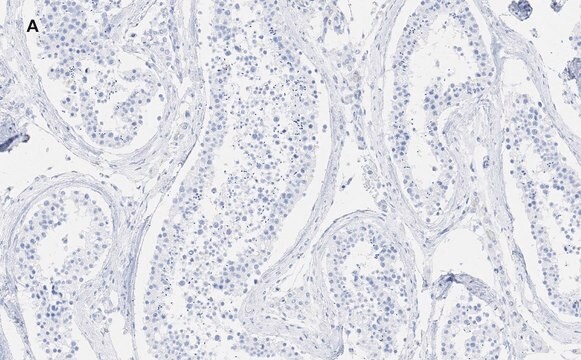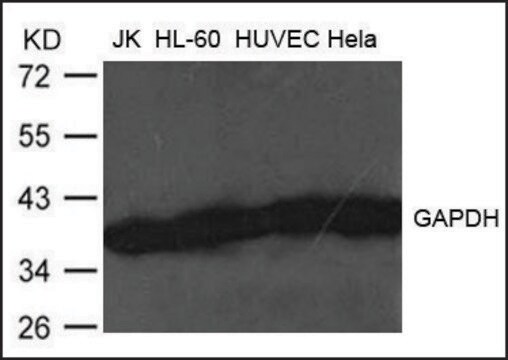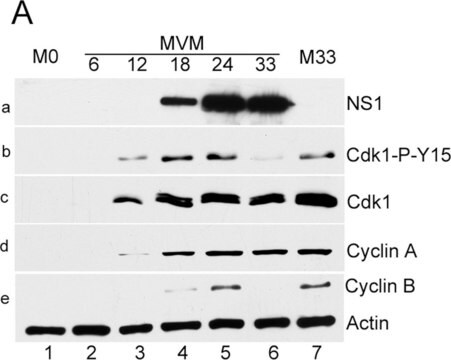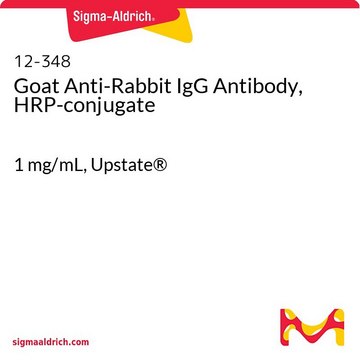MABN1773
Anti-oxDJ-1 Antibody (Cys106), clone M149
clone M149, from mouse
동의어(들):
Protein DJ-1, Oncogene DJ1, Parkinson disease protein 7, oxDJ-1 (Cys106)
로그인조직 및 계약 가격 보기
모든 사진(1)
About This Item
UNSPSC 코드:
12352203
eCl@ss:
32160702
NACRES:
NA.41
클론:
M149, monoclonal
application:
IHC
WB
WB
종 반응성:
mouse, human
기술:
immunohistochemistry: suitable
western blot: suitable
western blot: suitable
citations:
7
추천 제품
생물학적 소스
mouse
Quality Level
항체 형태
purified immunoglobulin
항체 생산 유형
primary antibodies
클론
M149, monoclonal
종 반응성
mouse, human
기술
immunohistochemistry: suitable
western blot: suitable
동형
IgG2aκ
NCBI 수납 번호
UniProt 수납 번호
배송 상태
wet ice
타겟 번역 후 변형
unmodified
유전자 정보
human ... PARK7(11315)
일반 설명
Protein DJ-1 (UniProt Q99497; also known as Parkinson disease (autosomal recessive, early onset) protein 7, Epididymis secretory sperm binding protein Li 67p, Oncogene DJ1) is encoded by the PARK7 (also known as DJ1, HEL-S-67p) gene (Gene ID 11315) in human. DJ-1 belongs to the ThiJ/PfpI family of proteins characterized by a ThiJ domain. DJ-1 is reported to be involved in multiple physiological processes, including cellular oncogenic transformation, RNA-protein interaction regulation, sperm fertilization, antioxidative defense, and transcriptional regulation. Mutations in the DJ-1 gene, PARK7, are known causes of autosomal recessive parkinsonism with a clinical presentation similar to other forms of recessive PD syndromes. DJ-1 cysteine residue 106 (Cys106) is preferentially oxidized through direct oxygen addition in response to cellular oxidative stress. Cysteine forms 3 different oxidized species, cysteine–sulfenic acid (Cys-SOH), cysteine–sulfinic acid (Cys-SO2H), and cysteine–sulfonic acid (Cys-SO3H). The Cys-SO2H form of oxDJ-1 is likely the active form, and further oxidation to Cys-SO3H leads to loss of biologic function. The levels of oxDJ-1 in erythrocytes from unmedicated PD patients are reported to be markedly higher than those from medicated PD patients and healthy subjects.
특이성
Immunoreactivity toward Cys-SO2H or Cys-SO3H form of oxDJ-1 is not yet determined.
면역원
Epitope: Cys106-SO2H/-SO3H
His-tagged oxidized recombinant DJ-1 purified from H2O2-treated E. coli host corresponding to the Cys106-SO2H/-SO3H of human oxDJ-1.
애플리케이션
Immunohistochemistry: A reporesentative lot detected DJ-1 oxidation in various regions of murine (cerebral cortex, hippocampus, striatum, SN pars compacta, SN pars reticulata) and human (SN and red nucleus of the midbrain) brain tissue sections (Saito, Y., et al. (2014). J Neuropathol Exp Neurol. 73(7):714-728.)
Western Blotting Analysis: A reporesentative lot detected basal DJ-1 oxidation (oxDJ-1) in human neuroblastoma SH-SY5Y cells and murine fibroblasts from wild-type, but not DJ-1 knockout, mice, as well as enhanced oxDJ-1 in H2O2-treated SH-SY5Y cells (Saito, Y., et al. (2014). J Neuropathol Exp Neurol. 73(7):714-728.).
Western Blotting Analysis: A reporesentative lot detected basal DJ-1 oxidation (oxDJ-1) in human neuroblastoma SH-SY5Y cells and murine fibroblasts from wild-type, but not DJ-1 knockout, mice, as well as enhanced oxDJ-1 in H2O2-treated SH-SY5Y cells (Saito, Y., et al. (2014). J Neuropathol Exp Neurol. 73(7):714-728.).
Research Category
Neuroscience
Neuroscience
Research Sub Category
Developmental Signaling
Developmental Signaling
This Anti-oxDJ-1 Antibody (Cys106), clone M149 is validated for use in Western Blotting and Immunohistochemistry for the detection of oxDJ-1.
품질
Evaluated by Western Blotting in SH-SY5Y cell lysate.
Western Blotting Analysis: 0.1 µg/mL of this antibody detected enhanced DJ-1 oxidation in 10 µg cell lysate from H2O2-treated human neuroblastoma SH-SY5Y cells.
Western Blotting Analysis: 0.1 µg/mL of this antibody detected enhanced DJ-1 oxidation in 10 µg cell lysate from H2O2-treated human neuroblastoma SH-SY5Y cells.
표적 설명
~20 kDa observed. Uncharacterized band(s) may appear in some lysates.
물리적 형태
Format: Purified
Protein G Purified
Purified mouse monoclonal IgG2aκ antibody in buffer containing 0.1 M Tris-Glycine (pH 7.4), 150 mM NaCl with 0.05% sodium azide.
저장 및 안정성
Stable for 1 year at 2-8°C from date of receipt.
기타 정보
Concentration: Please refer to lot specific datasheet.
면책조항
Unless otherwise stated in our catalog or other company documentation accompanying the product(s), our products are intended for research use only and are not to be used for any other purpose, which includes but is not limited to, unauthorized commercial uses, in vitro diagnostic uses, ex vivo or in vivo therapeutic uses or any type of consumption or application to humans or animals.
적합한 제품을 찾을 수 없으신가요?
당사의 제품 선택기 도구.을(를) 시도해 보세요.
Storage Class Code
12 - Non Combustible Liquids
WGK
WGK 1
Flash Point (°F)
Not applicable
Flash Point (°C)
Not applicable
시험 성적서(COA)
제품의 로트/배치 번호를 입력하여 시험 성적서(COA)을 검색하십시오. 로트 및 배치 번호는 제품 라벨에 있는 ‘로트’ 또는 ‘배치’라는 용어 뒤에서 찾을 수 있습니다.
Rui Sun et al.
Molecular & cellular proteomics : MCP, 16(10), 1789-1800 (2017-08-18)
4-Oxo-2-nonenal (ONE) derived from lipid peroxidation modifies nucleophiles and transduces redox signaling by its reactions with proteins. However, the molecular interactions between ONE and complex proteomes and their dynamics in situ remain largely unknown. Here we describe a quantitative chemoproteomic
Diana A Quintero-Espinosa et al.
Environmental toxicology, 37(3), 660-676 (2021-12-14)
It is increasingly evident that LRRK2 kinase activity is involved in oxidative stress (OS)-induced apoptosis-a type of regulated cell death and neurodegeneration, suggesting LRRK2 inhibition as a potential therapeutic target. We report that a phenolic-rich extract of avocado Persea americana
Yuichiro Mita et al.
Scientific reports, 8(1), 12056-12056 (2018-08-15)
DJ-1 plays an important role in antioxidant defenses, and a reactive cysteine at position 106 (Cys106) of DJ-1, a critical residue of its biological function, is oxidized under oxidative stress. DJ-1 oxidation has been reported in patients with Parkinson's disease
Katalin Solti et al.
Neurobiology of disease, 134, 104629-104629 (2019-11-02)
The loss of native function of the DJ-1 protein has been linked to the development of Parkinson's (PD) and other neurodegenerative diseases. Here we show that DJ-1 aggregates into β-sheet structured soluble and fibrillar aggregates in vitro under physiological conditions
Viviana Soto-Mercado et al.
PloS one, 15(5), e0221669-e0221669 (2020-05-22)
Alzheimer's disease (AD) is a neurodegenerative disorder characterized by progressive memory loss and cognitive disturbance as a consequence of the loss of cholinergic neurons in the brain, neuritic plaques and hyperphosphorylation of TAU protein. Although the underlying mechanisms leading to
자사의 과학자팀은 생명 과학, 재료 과학, 화학 합성, 크로마토그래피, 분석 및 기타 많은 영역을 포함한 모든 과학 분야에 경험이 있습니다..
고객지원팀으로 연락바랍니다.